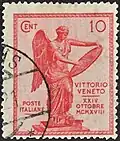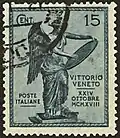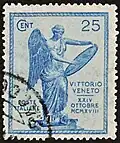Winged Victory of Brescia
| Winged Victory of Brescia | |
|---|---|
| Italian: Vittoria alata di Brescia | |
 Winged Victory in the Capitolium after restoration | |
| Artist | Unknown |
| Completion date | 1st century AD |
| Medium | bronze |
| Dimensions | 195 cm (77 in) |
| Location | Brescia, Italy |
The Winged Victory of Brescia is a bronze statue from the 1st century AD housed at the Capitolium of Brescia, where it was discovered in 1826 along with other Roman bronzes. The work is one of the symbols of the city of Brescia.
History and description
Initially believed to be a Hellenistic work executed around the mid-3rd century BC by a Greek master and later reworked in Roman imperial times, based on studies conducted in the early 19th century, the statue was recognized as a pastiche, meaning an assemblage created in Roman times, likely after 69 AD, based on a previous Hellenistic casting.[1] The new restoration by the Opificio delle Pietre Dure has established that the statue was cast in the 1st century AD in a local foundry and is not an assemblage of different statues but was created to be a "Winged Victory." The reference model is identified as the Afrodite Urania of the "Cyrene type," meaning the goddess conceived in that specific variation of posture found in the statue discovered at Cyrene. Other details, such as the torsion of the torso and the positioning of the arms, are similarly derived from Greek works of the 5th–6th century BC.[1] The figure wears a chiton fastened at the shoulders and a himation that wraps around the lower limbs. The left leg is slightly raised, as it is believed the foot rested on the helmet of Mars; to complete the work, a silver and copper damascening was placed on the head to adorn the hair. In Roman times, wings were added to transform the work into the goddess Victoria; similar works (Victory inscribing a shield) were present in Rome and Constantinople in the imperial forums. After centuries of oblivion, the work was discovered on the evening of July 20, 1826, partially disassembled and carefully hidden in the western cavity of the Capitolium between the temple and the Cidneo, along with many other bronze pieces, including a series of portraits, likely to prevent it from being melted down for weapons during invasions by barbarian peoples (Goths and Huns).[1] This explains its exceptional state of preservation.
With the advent of World War I, the Victory, along with numerous other works of artistic and cultural heritage, was transferred to Rome by order of the government as a precaution to keep them safe from the front lines. After the conflict, Senator Pompeo Gherardo Molmenti was appointed Undersecretary for Antiquities and Fine Arts, tasked with ensuring that the masterpieces moved to Rome were returned to their original locations; Molmenti personally oversaw the transport and return of the Victory to Brescia, which took place with a solemn celebration in April 1920.[2][3]
The statue was loaned and exhibited from November 1948 to March 1949 at the Kunsthaus Zürich museum for the event exhibition titled Kunstschätze der Lombardei. 500 vor Christus, 1800 nach Christus.[4][5]
- Initial hypothesis According to early studies, a hypothesis was formulated about how the statue arrived in Brescia. According to this hypothesis, the statue was transported to Rome at the behest of Augustus after the death of Cleopatra in 29 BC and then donated directly to Brixia as a sign of political goodwill, perhaps on the occasion of the city being granted the title of Colonia Augusta. The work was then transformed into Nike after the Second Battle of Bedriacum, which marked the triumph of Marcus Antonius Primus, lieutenant of Vespasian, over Vitellius. It was Vespasian himself, after the battle that enabled his rise to the throne, who ordered the monumental renovation of the forum and the Capitoline temple of the city, and it was assumed that the statue's transformation from Aphrodite to Victory occurred on this occasion. The goddess's posture would have changed from the vanity of gazing at herself to the act of writing a dedicatory inscription with a stylus on the shield of Ares, which was later lost, while two large feathered wings were mounted on her back.[1]
- Subsequent studies The consensus on the previous hypothesis, which had long been predominant, weakened following further investigations conducted using X-ray fluorescence. The analyses revealed no significant differences between the wings and the body of the statue, an homogeneity that likely indicated the work was created in a single constructive process.[6] The sculpture was analyzed and studied by Edilberto Formigli and Andrea Salcuni as part of a research project by the Institute of Archaeological Sciences of the Goethe University Frankfurt.[7] In July 2018,[8] the work was entrusted to experts from the Opificio delle Pietre Dure, assisted by specialists from the Sapienza University of Rome; the statue underwent restoration and was the subject of a joint interdisciplinary study involving archaeologists, scientific consultants, engineers, and restorers.[9][10][11]
After the restoration, a structure—designed by Spanish architect Juan Navarro Baldeweg[12] who also redesigned its display—was created at the Capitolium to house the monument, equipped with a new earthquake-resistant base.[13][14][15]
Details
The Winged Victory of Brescia in the world
- Bologna: Plaster cast at the gypsotheque of the Archaeological Civic Museum of Bologna
- Bolsena: Gilded bronze reproduction, atop the marble column of the war memorial.[16]
- Brescia: The original Winged Victory housed at the Capitolium
- Brescia: Copy housed at Palazzo della Loggia, originally intended for the American president Woodrow Wilson.[5][17]
- Brescia: 1935 bronze reproduction, donated by Roberto Ferrari,[18] located in the "Cloister of Memory"[19][20] of the former Santi Cosma e Damiano
- Brescia: Reproduction, donated by the Rotary Club, placed at the center of the roundabout on Via Labirinto.[21]
- Carcare: 1919 bronze reproduction by Paolo Enrico De Barbieri, part of the war memorial in Piazza Guglielmo Marconi.[22]
- Gardone Riviera: Wingless bronze copy, commissioned in 1934 by Gabriele D’Annunzio to sculptor Renato Brozzi for placement in the Tempietto della Vittoria at the Vittoriale degli Italiani.[23]
- Isorella: Reproduction placed in Piazza Roma, in front of the town hall.[24]
- Passo del Tonale: Copy created in the 1920s by sculptor Timo Bortolotti for the Victory Monument, later incorporated into the Tonale Military Memorial.[25]
- Rome: Plaster cast at the Museum of Roman Civilization.[26]
- Rome: Copy at Palazzo Chigi.[27][28][29]
- Rovereto: Reproduction at the Italian War History Museum housed in the Rovereto Castle
- Trento: Bronze reproduction at the Fondazione Museo Storico del Trentino
- Santicolo in Corteno Golgi: Bronze reproduction atop the war memorial.[30]
.jpg)
- Paris: Bronze reproduction along the Escalier Colbert in the Louvre Museum. The copy was cast in 1861 at the Parisian foundry of "Eck et Durand" thanks to the plaster cast made by Pietro Pierotti and donated by the city of Brescia to Napoleon III after the victory in the Battle of Solferino in 1859.[31]
- Paris: Plaster copy in the atrium of the private residence of Louis-Napoléon located on Avenue Montaigne.[32]
- Versailles: Plaster cast by Pietro Pierotti, housed in the Louvre's storage facilities located in the Versailles stables
- Berlin: Plaster copy at the gypsotheque of the Berlin State Museums.[33]
- Berlin: Plaster cast at the Abguss-Sammlung Antiker Plastik of the Free University of Berlin.[34]
- Dresden: Plaster copy sent to the Dresden Academy of Fine Arts in 1873
- Cambridge: Plaster copy, purchased by Louis Alexander Fagan[35] in 1877, for the gypsotheque of the Fitzwilliam Museum
- Přestanov: Large-scale reproduction atop the column of the monument, designed by architect Pietro Nobile in 1836, commemorating the victory against Napoleon Bonaparte in Bohemia.[36][37][38]
- Saint Petersburg: At the Stieglitz Museum
- Valladolid: Plaster replica granted in 1888 to the Museo de reproducciones artísticas[39] in Madrid, where it was housed until the end of 2011,[40][41] when the museum was absorbed by the National Sculpture Museum in Valladolid
- Boston: At the Museum of Fine Arts
- New York City: Plaster cast at the Metropolitan Museum of Art
- San Simeon: Bronze replica at Hearst Castle in California, by sculptor Umberto Marcellini in the early 20th century
- Zurich: Zurich Museum
In popular culture
Philately
The Victory of Brescia was the subject of a series of stamps of the Kingdom of Italy, created by Alberto Repettati, for the third anniversary of the victory in the Battle of Vittorio Veneto.[42][43][44][45][46] The series,[47] printed by the Turin paper securities office, was issued by Italian Post on November 1, 1921, and also in the Italian colonies[48] of Eritrea, Libya, and Italian Somalia.[49][50][51]
On the occasion of the restoration, on November 21, 2020, the Ministry of Economic Development issued a new stamp, printed by the Istituto Poligrafico e Zecca dello Stato, depicting the statue in a stylized graphic by Paolo Tassinari.[52][53]
Civic image
On the occasion of the "First International Air Circuit,"[54][55][56][57] the first Italian aviation event held from September 8 to 20, 1909, between Montichiari and Ghedi, the Winged Victory of Brescia was used as a civic symbol in informational and promotional materials related to the event.[58][59][60] A similar example was the use of the statue's image in illustrations for tourism promotion of the city of Brescia[61] by the ENIT.
Literature
Antoine-Claude Pasquin Valéry dedicates a chapter to it in his work Voyages historiques et littéraire en Italie.[62]
Giosuè Carducci celebrated it in the Alcaic ode Alla Vittoria, written in May 1877, included in the Barbarian Odes, and inspired by two visits the poet made to Brescia, the first in the summer of 1871 with Carolina Cristofori, the second in October 1876.
Gabriele D’Annunzio was reverently fascinated by the Victory and celebrated it extensively throughout his life: it appears in the sonnet dedicated to Brescia, included in Elettra (D'Annunzio), the second book of the Laudi, and it inspired him so much that he depicted it in the novel Forse che sì forse che no.[63][64][65]
The magazine Topolino dedicated a comic story to it in issue number 3391.[66][67]
Numismatics
A detail of the statue's face is depicted on the reverse of the first coin in the 2023 Italian Republic numismatic collection, issued on February 20, 2023, and dedicated to the cities of Bergamo and Brescia as Italian Capitals of Culture for 2023.[68][69][70]
See also
References
- ^ a b c d Stella, Clara (2003). Brixia. Scoperte e riscoperte [Brixia. Discoveries and Rediscoveries] (in Italian). Milano: Skira. ISBN 978-88-8491-540-5.
- ^ Maria Paola Pasini (2018). Emilio Franzina; Mariano Nardello (eds.). A due passi dal fronte. Città di retrovia e cultura urbana nel prisma della Grande Guerra [Two Steps from the Front. Rear Cities and Urban Culture in the Prism of the Great War]. International Conference "A due passi dal fronte. Città di retrovia e culture urbane nel prisma della grande guerra fra esperienza bellica e propaganda", Odeo del Teatro Olimpico, Vicenza, May 19–20, 2015 (in Italian). Mantova: Tre Lune Edizioni. pp. 621–644. ISBN 978-88-89832-79-0.
- ^ Maria Paola Pasini (2016). Capolavori in guerra. Il salvataggio dell'arte bresciana durante i conflitti del Novecento [Masterpieces in War. The Rescue of Brescian Art During the Conflicts of the Twentieth Century] (in Italian). Brescia: Morcelliana. ISBN 9788837230548.
- ^ Francesca Morandini; Piera Tabaglio (2016). L'archivio fotografico dei Musei Civici di Brescia e la valorizzazione del patrimonio archeologico [The Photographic Archive of the Civic Museums of Brescia and the Enhancement of the Archaeological Heritage] (PDF). Study Meeting "Archeologia e documentazione fotografica d'archivio. Dal dagherrotipo all'avvento della fotografia digitale", Aquileia, April 28–29, 2016 (in Italian). Vol. anno XXVI. Udine-Trieste: Società friulana di archeologia – Editreg. pp. 103–112. ISSN 1122-7133.
- ^ a b Maria Paola Pasini (September 6, 2014). "La Vittoria viaggiatrice. Le trasferte a Roma, Zurigo e nella Bassa" [The Traveling Victory. Trips to Rome, Zurich, and the Lowlands]. Corriere della Sera (in Italian). Brescia. p. 13.
- ^ Taddia, Marco (2012). Arnaudon e la Vittoria Alata di Brescia [Arnaudon and the Winged Victory of Brescia] (in Italian). Roma: Aracne Editrice.
- ^ Alberto Ottaviano (2012). "Statua simbolo di Brescia: la Vittoria alata parlava latino e non greco antico" [Symbol Statue of Brescia: The Winged Victory Spoke Latin, Not Ancient Greek] (PDF). Notiziario (in Italian) (4). Brescia: C.E.R. ANCE Brescia: 238–241. Retrieved December 20, 2017.
- ^ "Vittoria alata, a Firenze sotto i ferri: il punto sul restauro" [Winged Victory, in Florence Under the Knife: Update on the Restoration]. Giornale di Brescia (in Italian). May 26, 2019. Retrieved May 27, 2020.
- ^ "Il restauro della Vittoria Alata di Brescia" [The Restoration of the Winged Victory of Brescia] (in Italian). Opificio delle Pietre Dure. 2020. Retrieved June 27, 2020.
- ^ Giorgio Bonsanti (2019). "Bronzi antichi: la Vittoria Alata di Brescia" [Ancient Bronzes: The Winged Victory of Brescia]. Il Giornale dell'Arte (in Italian). No. 399. Retrieved June 27, 2020.
- ^ Helga Marsala (April 15, 2017). "Tre aziende sostengono i restauri della magnifica Vittoria Alata di Brescia. Grazie all'Art Bonus" [Three Companies Support the Restoration of the Magnificent Winged Victory of Brescia. Thanks to Art Bonus]. Artribune (in Italian). Retrieved June 27, 2020.
- ^ "La Vittoria Alata musa ispiratrice dell'archistar Baldeweg" [The Winged Victory, Muse of the Archistar Baldeweg]. Giornale di Brescia (in Italian). April 16, 2019. Retrieved May 27, 2020.
- ^ Marcello Barbanera (May 17, 2020). "La Vittoria di Brescia, che scrive sull'invisibile scudo" [The Victory of Brescia, Writing on the Invisible Shield]. il manifesto (in Italian). Retrieved May 27, 2020.
- ^ Francesca Grego (January 14, 2020). "Sulle ali della Vittoria: a Brescia il 2020 è nel segno dell'archeologia" [On the Wings of Victory: In Brescia, 2020 is Marked by Archaeology]. ARTE.it (in Italian). Retrieved June 27, 2020.
- ^ Federica Pacella (July 21, 2019). "Brescia, il compleanno della Vittoria Alata" [Brescia, the Birthday of the Winged Victory]. Il Giorno (in Italian). Retrieved May 27, 2020.
- ^ Raffaella Bruti (2017). "Il monumento di Bolsena e i suoi caduti". In Raffaella Bruti (ed.). Dal solco alla trincea. La Grande Guerra nel territorio del lago di Bolsena attraverso i suoi protagonisti [From the Furrow to the Trench. The Great War in the Lake Bolsena Territory Through Its Protagonists] (PDF) (in Italian). Vol. 1. Acquapendente: Sistema Bibliotecario "Lago di Bolsena". pp. 10–37. ISBN 978-88-95034-21-8. Archived from the original (PDF) on December 2, 2021. Retrieved April 29, 2019.
- ^ Maria Paola Pasini (September 6, 2014). "E Brescia ne offrì una copia al presidente Usa" [And Brescia Offered a Copy to the US President]. Corriere della Sera (in Italian). Brescia. p. 13.
- ^ Antonio Fappani, ed. (1981). "Ferrari Roberto". Enciclopedia bresciana (in Italian). Vol. 4. Brescia: La Voce del Popolo. p. 130. OCLC 163181951.
- ^ "Comunicato stampa: "Riscoprire il Chiostro della Memoria. Un monumento della città per non dimenticare"" [Press Release: "Rediscovering the Cloister of Memory. A City Monument to Remember"] (PDF) (in Italian). p. 6. Retrieved April 24, 2019 – via turismobrescia.it.
- ^ Antonio Fappani, ed. (1985). "Istituzione della Memoria" [Memory Institution]. Enciclopedia bresciana (in Italian). Vol. 6. Brescia: La Voce del Popolo. p. 361. OCLC 163181975.
- ^ Angela Dessì (May 23, 2010). "Il Rotary? A Brescia 16 circoli e 796 soci" [The Rotary? In Brescia, 16 Clubs and 796 Members]. Bresciaoggi (in Italian). Archived from the original on April 23, 2019. Retrieved April 22, 2019.
- ^ "Monumento ai caduti della prima guerra mondiale" [Monument to the Fallen of the First World War]. catalogo.beniculturali.it (in Italian). MiBAC – ICCD. Retrieved May 4, 2019.
- ^ Bonoldi, Lorenzo (2005). Nachleben e vittorie postume della Venus Victrix di Brescia [Afterlife and Posthumous Victories of the Venus Victrix of Brescia] (in Italian). Venezia: Associazione Culturale Engramma.
- ^ Antonio Fappani, ed. (1985). "Isorella: Apici e pedici" [Isorella: Superscripts and subscripts]. Enciclopedia bresciana (in Italian). Vol. 6. Brescia: La Voce del Popolo. p. 305. OCLC 163181975.
- ^ "Timo Bortolotti – Presentazione" [Timo Bortolotti – Presentation]. timobortolotti.it (in Italian). Retrieved August 21, 2018.
- ^ "Statua bronzea di Vittoria Alata (seconda metà del I sec. d.C)" [Bronze Statue of Winged Victory (Second Half of the 1st Century AD)] (in Italian). Retrieved April 30, 2019.
- ^ "Palazzo Chigi – Radiomessaggio celebrativo letto dal ministro degli esteri Ciano nell'annuale della stipulazione del patto anticomunista italo-tedesco-nipponico" [Palazzo Chigi – Commemorative Radio Message Read by Foreign Minister Ciano on the Anniversary of the Italo-German-Japanese Anti-Communist Pact] (in Italian). Retrieved April 22, 2019.
- ^ "Roma Il ministro Ciano, ripreso nel salone della Vittoria, sfoglia il testo della dichiarazione italo-britannica affiancato da un segretario" [Rome: Minister Ciano, Filmed in the Victory Hall, Reviews the Text of the Italo-British Declaration Accompanied by a Secretary] (in Italian). Retrieved April 22, 2019.
- ^ "Mussolini riceve a Palazzo Chigi studenti universitari bulgari e ungheresi" [Mussolini Receives Bulgarian and Hungarian University Students at Palazzo Chigi] (in Italian). Retrieved April 22, 2019.
- ^ Antonio Fappani, ed. (2000). "Santicolo". Enciclopedia bresciana (in Italian). Vol. 16. Brescia: La Voce del Popolo. p. 266. OCLC 955451555.
- ^ "La Vittoria Alata" [The Winged Victory] (in Italian). Archived from the original on April 24, 2019. Retrieved April 23, 2019.
- ^ Louise Colet (1862). L'Italie des italiens [The Italy of the Italians] (in French). Vol. 1. Paris: E. Dentu, éditeur. p. 342.
- ^ "Kopf der Victoria von Brescia" [Head of the Victoria of Brescia]. iDAI.objects arachne (in German). German Archaeological Institute and Archaeological Institute of the University of Cologne. Retrieved April 24, 2019.
- ^ "Victoria von Brescia" [Victory of Brescia]. iDAI.objects arachne (in German). German Archaeological Institute and Archaeological Institute of the University of Cologne. Retrieved April 24, 2019.
- ^ "Louis Fagan (1845–1903)". Bnf – National Library of France (in French). Retrieved April 24, 2019.
- ^ "Pamětihodnosti – Památník bitvy u Přestanova z roku 1836" [Monuments – Monument to the Battle of Přestanov from 1836] (in Czech). Retrieved April 22, 2019.
- ^ "Bitva u Chlumce a Přestanova" [Battle of Chlumec and Přestanov] (in Czech). Retrieved April 22, 2019.
- ^ "Pomník bitvy u Přestanova" [Monument to the Battle of Přestanov] (in Czech). Retrieved April 22, 2019.
- ^ Daniel Casado Rigalt (2006). José Ramón Mélida (1856–1833) y la Arqueología española [José Ramón Mélida (1856-1933) and Spanish Archaeology] (in Spanish) (1 ed.). Madrid: Real Academia de la Historia. p. 307, fig. 60. ISBN 978-84-95983-72-5.
- ^ "El Museo Nacional de Escultura recupera su nombre e incorpora nuevos fondos" [The National Sculpture Museum Recovers Its Name and Incorporates New Collections]. El Mundo (in Spanish). Madrid. November 18, 2011. Retrieved April 23, 2019.
- ^ Roger Salas (August 16, 2014). "La memoria de los escultores" [The Memory of the Sculptors]. El País (in Spanish). Madrid. Retrieved April 23, 2019.
- ^ Bonoldi, Lorenzo (2005). Nachleben e vittorie postume della Venus Victrix di Brescia [Afterlife and Posthumous Victories of the Venus Victrix of Brescia] (in Italian). Venezia: Associazione Culturale Engramma.
- ^ Santoro, Valentina (2016). Il recupero dei modelli classici nei monumenti ai caduti: l'iconografia della Vittoria alata. La Victoria in clipeo scribens [The Recovery of Classical Models in War Memorials: The Iconography of the Winged Victory. The Victoria in Clipeo Scribens] (in Italian). MiBAC – ICCD.
- ^ Federico Zeri (1993). I francobolli italiani. Grafica e ideologia dalle origini al 1948 [Italian Stamps. Graphics and Ideology from Origins to 1948] (in Italian). Genova: Il Melangolo. p. 27. ISBN 978-88-7018-213-2.
- ^ "Rivista marittima". Rivista marittima (in Italian). Roma: Ministero della marina: 214. 1952.
- ^ Vincenzo De Luca (April 5, 2019). "L'anniversario della prima guerra mondiale e la filatelia" [The Anniversary of the First World War and Philately] (PDF) (in Italian). Retrieved February 6, 2021 – via Associazione nazionale commissariato militare.
[...] Nei primi anni successivi alla fine della guerra [...] troviamo la prima serie che celebra nel 1921 la Vittoria di Vittorio Veneto con quattro valori da centesimi 5, 10, 15, e 25. [...]
[[...] In the first years following the end of the war [...] we find the first series celebrating the Victory of Vittorio Veneto in 1921 with four values of cents 5, 10, 15, and 25. [...]] - ^ The series consists of four types: 5 cents in green, 10 cents in red, 15 cents in gray, and 20 cents in blue.
- ^ For colonial issues, the decree provided for overprints in black ink bearing the texts: Eritrea, Libia, Somalia italiana. In the specific case of Italian Somalia, the value converted into the local currency (Somali rupee) was also indicated, respectively: 3, 6, 9, and 15 bes.
- ^ "Regio decreto n. 908 del 4 maggio 1922" [Royal Decree No. 908 of 4 May 1922] (pdf). Gazzetta Ufficiale del Regno d'Italia (in Italian) (167): 1687–1688. July 17, 1922. Retrieved December 20, 2020.
- ^ "Bollettino del Ministero delle Poste e dei Telegrafi" [Bulletin of the Ministry of Posts and Telegraphs] (PDF). Bollettino del Ministero delle Poste e dei Telegrafi (in Italian). parte seconda (22): 772–773. August 1, 1922. Retrieved December 20, 2020 – via issp.po.it – Istituto di studi storici postali "Aldo Cecchi" onlus.
- ^ "Anniversario Vittoria" [Victory Anniversary] (in Italian). Retrieved December 20, 2020.
- ^ "La filatelia omaggia la Vittoria alata di Brescia" [Philately Honors the Winged Victory of Brescia] (in Italian). November 23, 2020. Retrieved December 20, 2020.
- ^ "Emissione di un francobollo ordinario appartenente alla serie tematica "il patrimonio artistico e culturale italiano" dedicato alla statua della Vittoria Alata" [Issuance of an Ordinary Stamp from the Thematic Series "Italian Artistic and Cultural Heritage" Dedicated to the Winged Victory Statue] (PDF) (in Italian). November 21, 2020. Retrieved December 20, 2020.
- ^ "Primo Circuito Aereo Italiano" [First Italian Air Circuit]. La Sentinella Bresciana (in Italian). No. 247. September 16, 1909.
- ^ "Il primo circuito aereo italiano a Brescia – Una gara di aviazione" [The First Italian Air Circuit in Brescia – An Aviation Competition]. La Tribuna illustrata (in Italian). No. 38. Roma. September 19, 1909.
- ^ Franz Kafka (September 29, 1909). "Die Aeroplane in Brescia" [The Airplanes in Brescia]. Bohemia (in German). No. 269. Prague: Andreas Haase.
- ^ Alessandro Arseni (2009). "Il circuito Aereo di Brescia" [The Brescia Air Circuit] (PDF). The Postal Gazette. Year IV (in Italian). 21 (2). Melano: 20–21. Retrieved April 27, 2019.
- ^ Luigi Barzini; Luca Beltrami; Augusto Guido Bianchi; Pietro Croci; Arnaldo Fraccaroli; Vittorio Gottardi; Ettore Janni; Edgardo Longoni; Renato Simoni (1909). Il circuito aereo di Brescia. Guida ufficiale [The Brescia Air Circuit. Official Guide] (PDF) (in Italian). Archived from the original (PDF) on August 16, 2016. Retrieved April 27, 2019 – via avia-it.com.
- ^ Peter Demetz (2002). The air show at Brescia (1 ed.). New York: Farrar, Straus and Giroux. ISBN 9780374102593.
- ^ Aldo Mazza (1909). Manifesto del Primo Circuito Aereo Brescia [Poster of the First Brescia Air Circuit] (in Italian).
- ^ Brescia (in Italian). Ente Nazionale Industrie Turistiche. Archived from the original on March 16, 2015. Retrieved May 4, 2019.
- ^ Antoine-Claude Pasquin Valéry (1831). Voyages historiques et littéraire en Italie ou l'Indicateur italien. Pendant les années 1826, 1827 et 1828 [Historical and Literary Travels in Italy or the Italian Guide. During the Years 1826, 1827, and 1828] (in French). Vol. tome I. Paris: Imprimerie de Crapelet – chez Le Normant, libraire. pp. 239–240.
- ^ Marina Candiani (2013). "D'Annunzio nel Settantesimo della morte" [D’Annunzio on the Seventieth Anniversary of His Death] (PDF). Commentari dell'Ateneo di Brescia (in Italian). per l’anno 2008. Brescia: Fratelli Geroldi: 129–138. ISSN 0375-6181.
- ^ Raffaella Castagnola (1998). "Dalle carceri del Museo all'aria aperta. D'Annunzio e l'immaginario simbolico della "Vittoria" di Brescia" [From Museum Prisons to the Open Air. D'Annunzio and the symbolic imagery of Brescia's "Victory."]. In Marcello Ciccuto; Alexandra Zingone (eds.). I segni incrociati. Letteratura italiana del '900 e Arte figurativa [Crossed Signs. Twentieth-Century Italian Literature and Figurative Art] (in Italian). Viareggio: Mauro Baroni Editore. pp. 55–74. OCLC 807208753.
- ^ Antonio Fappani, ed. (1978). "D'Annunzio Gabriele". Enciclopedia bresciana]] (in Italian). Vol. 3. Brescia: La Voce del Popolo. OCLC 163181930.
- ^ Roberto Gagnor (w), Valerio Held (a). Topolino, no. 3391 (August 17, 2020). Modena: Panini, (in Italian).
- ^ "Il grande ritorno di Minni Alata" [The Great Return of Winged Minnie] (in Italian). Retrieved November 17, 2020.
- ^ "Bergamo e Brescia: una moneta speciale per le due città esempio "di resilienza e di rinascita culturale"" [Bergamo and Brescia: A Special Coin for the Two Cities, Examples of "Resilience and Cultural Rebirth"] (PDF) (in Italian). Istituto Poligrafico e Zecca dello Stato. February 20, 2023. Retrieved February 20, 2023.
- ^ "Collezione Numismatica: emessa la prima moneta della Collezione 2023 dedicata a Bergamo e Brescia "capitali italiane della cultura 2023"" [Numismatic Collection: Issued the First Coin of the 2023 Collection Dedicated to Bergamo and Brescia "Italian Capitals of Culture 2023"] (in Italian). Dipartimento del tesoro – Ministero dell’economia e delle finanze. February 20, 2023. Retrieved February 20, 2023.
- ^ "Catalogo della Collezione numismatica 2023" [Catalog of the 2023 Numismatic Collection] (PDF) (in Italian). Istituto Poligrafico e Zecca dello Stato. p. 3. Retrieved February 20, 2023.
Bibliography
- Clara Stella, ed. (2003). Brixia. Scoperte e riscoperte [Brixia. Discoveries and Rediscoveries] (in Italian). Milano: Skira. ISBN 978-88-8491-540-5.
- Lorenzo Bonoldi; Monica Centanni; Luana Lovisetto (2003). "Venus volubilis/venusta Victoria. Tradimenti, travestimenti, capricci, denudamenti dell'Afrodite di Brescia" [Venus Volubilis/Venusta Victoria. Betrayals, Disguises, Whims, and Unveilings of the Aphrodite of Brescia]. La Rivista di Engramma. La tradizione classica nella memoria occidentale. Third series (in Italian) (25). Venezia: Associazione Culturale Engramma. ISSN 1826-901X.
- Lorenzo Bonoldi (2005). "Nachleben e vittorie postume della Venus Victrix di Brescia" [Afterlife and Posthumous Victories of the Venus Victrix of Brescia]. La Rivista di Engramma. La tradizione classica nella memoria occidentale. Third series (in Italian) (41). Venezia: Associazione Culturale Engramma. ISSN 1826-901X.
- Pierfabio Panazza (2013). "La Vittoria Alata a Parigi: testimonianze inedite dall'archivio della famiglia Lechi" [The Winged Victory in Paris: Unpublished Testimonies from the Lechi Family Archive] (PDF). Commentari dell'Ateneo di Brescia (in Italian). per l’anno 2008. Brescia: Fratelli Geroldi: 69–102. ISSN 0375-6181.
- Pietro Lechi (2013). "Nuovi inediti intorno alla Vittoria Alata. Con cenni sull'origine dei documenti nell'archivio di famiglia" [New Unpublished Documents on the Winged Victory. With Notes on the Origin of Documents in the Family Archive] (PDF). Commentari dell'Ateneo di Brescia (in Italian). per l’anno 2008. Brescia: Fratelli Geroldi: 103–112. ISSN 0375-6181.
- Marco Taddia (2012). Arnaudon e la Vittoria Alata di Brescia [Arnaudon and the Winged Victory of Brescia] (PDF). Storia della Chimica applicata alla conservazione dei Beni Culturali, Roma, June 14, 2010. series V (in Italian). Vol. 34 (1 ed.). Roma: Aracne Editrice. pp. 199–211. ISBN 978-88-548-4598-5. ISSN 0392-4130.
- Andrea Salcuni; Edilberto Formigli, eds. (2011). Grandi bronzi romani dall'Italia settentrionale. Brescia, Cividate Camuno e Verona [Large Roman Bronzes from Northern Italy. Brescia, Cividate Camuno, and Verona] (in Italian). Bonn: Dr. Rudolf Habelt Verlag. ISBN 978-3-7749-3762-8.
- Gian Paolo Treccani (2010). ""Liberare i segni di Roma". Archeologia e centro storico nel caso di Brescia, 1823–1941" ["Liberating the Signs of Rome. Archaeology and the historic center in the case of Brescia, 1823–1941]. In Gian Paolo Treccani (ed.). Aree archeologiche e centri storici. Costituzione dei Parchi archeologici e processi di trasformazione urbana [Archaeological Areas and Historic Centers. Establishment of Archaeological Parks and Urban Transformation Processes] (in Italian). Milano: FrancoAngeli. pp. 63–91. ISBN 978-88-568-2255-7.
- Francesca Morandini; Anna Patera, eds. (2021). La Vittoria Alata di Brescia. Non ho visto nulla di più bello [The Winged Victory of Brescia. I Have Seen Nothing More Beautiful] (in Italian). Milano: Skira. ISBN 9788857244471.








